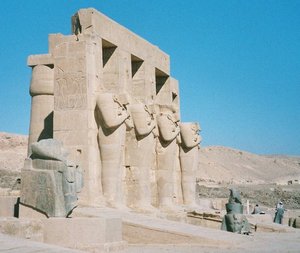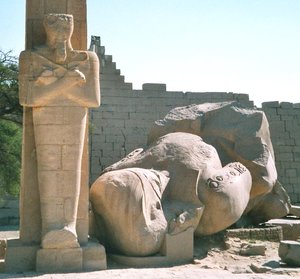Ramesseum
|
|
The Ramesseum is the memorial temple (or mortuary temple) of Pharaoh Ramesses II ("Ramesses the Great", also spelt "Ramses" and "Rameses"). It is located in the Theban necropolis in Upper Egypt, across the River Nile from the modern city of Luxor. The name – or at least its French form, Rhamesséion – was coined by Jean-François Champollion, who visited the ruins of the site in 1829 and first identified the hieroglyphs making up Ramesses's names and titles on the walls.
Egypt.Ramesseum.02.jpg
Ramesses II was a 19th dynasty pharaoh of Egypt. He ruled for 67 years during the 13th century BC, the apogee of Ancient Egypt's power and glory. This extraordinarily long reign, the wealth available in the state coffers, and, undeniably, the pharaoh's personal vanity meant that Ramesses, of all the ancient rulers, left what is perhaps the most indelible mark on the country. His legacy can be seen most clearly in the archaeological record – in the many buildings that Ramesses modified, usurped, or constructed from the ground up.
Most splendid of these, in accordance with New Kingdom burial practices, would have been his memorial temple – a place of worship dedicated to pharaoh, god on earth, where his memory would have been kept alive after his passing from this world. Surviving records indicate that work on the project began shortly after the start of his reign and continued for 20 years.
The design of Ramesses's mortuary temple abides by the standard canons of New Kingdom temple architecture. The main building, dedicated to the funerary cult, comprised two stone pylons (gateways, some 60 m wide), one after the other, each leading into a courtyard. Beyond the second courtyard, at the centre of the complex, was a covered 48-column hypostyle hall, surrounding the inner sanctuary.

As is customary, the pylons and outer walls were decorated with scenes commemorating pharaoh's military victories and leaving due record of his dedication to, and kinship with, the gods. In Ramesses's case, much importance is placed on the Battle of Kadesh (ca. 1285 BC); more intriguingly, however, one block atop the first pylon records his pillaging, in the eighth year of his reign, a city called "Shalem", which may or may not have been Jerusalem.
Adjacent to the north of the hypostyle hall was a smaller temple; this was dedicated to Ramesses's mother, Tuya, and his beloved chief wife, Nefertari. To the south of the first courtyard stood the temple palace. The entire complex was surrounded by various storerooms, granaries, workshops, and other ancillary buildings, some built as late as Roman times. A cache of papyri and ostraca dating back to the third intermediate period (11th to 8th centuries BC) indicates that the temple was also the site of an important scribal school. And neither was this a virgin plot when Ramesses had the first stone put in place: beneath the hypostyle hall, modern archaeologists have found a shaft tomb from the Middle Kingdom, yielding a rich hoard of religious and funerary artefacts.
Unlike the massive stone temples that Ramesses ordered carved from the face of the Nubian mountains at Abu Simbel, the inexorable passage of three millennia was not kind to his "temple of a million years" at Thebes. This was mostly due to its location on the very edge of the Nile floodplain, with the annual inundation gradually undermining the foundations of this temple, and its neighbours. Neglect and the arrival of new faiths also took their toll: for example, in the early years of the Common Era, the temple was put into service as a Christian church.
This is all standard fare for a temple of its kind built at the time it was. Leaving aside the escalation of scale – whereby each successive New Kingdom pharaoh strove to outdo his predecessors in volume and scope – the Ramesseum is largely cast in the same mould as Ramesses III's Medinet Habu or the ruined temple of Amenhotep III that stood behind the "Colossi of Memnon" a kilometre or so away. Instead, the significance that the Ramesseum enjoys today owes more to the time and manner of its rediscovery by Europeans.
The origins of modern Egyptology can be traced to the arrival in Egypt of Napoleon Bonaparte in the summer of 1798. While undeniably an invasion by an alien imperialist power, this was nonetheless an invasion of its times, informed by Enlightenment ideas: alongside Napoleon's troops went men of science, the same whose toil under the desert sun would later yield the seminal 23-volume Description de l'Égypte. Two French engineers, Jean Jollois and René Devilliers, were assigned to study the Ramesseum site, and it was with much fanfare that they identified it with the "Tomb of Ozymandias" or "Palace of Memnon" of which Diodorus of Sicily had written in the 1st century BC.
The next visitor of note was Giovanni Belzoni, a showman and engineer of Italian origin and, latterly, an archaeologist and antiques dealer. Belzoni's travels took him in 1815 to Cairo, where he sold Mehemet Ali a hydraulic engine of his own invention. There he met British Consul General Henry Salt, who hired his services to collect from the temple in Thebes one of two colossal granite heads depicting Ramesses II and transport it to England. Thanks to Belzoni's hydraulics and his skill as an engineer (Napoleon's men had failed in the same endeavour a decade or so earlier), the 7-ton stone head arrived in London in 1818, where it was dubbed "The Younger Memnon" and, some years later, given pride of place in the British Museum.
It was against the backdrop of intense excitement surrounding the statue's arrival, and having heard wondrous tales of other, less transportable treasures still in the desert, that the poet Percy Bysshe Shelley penned his sonnet "Ozymandias". In particular, one massive fallen statue at the Ramesseum is now inextricably linked with Shelley, because of the cartouche on its shoulder bearing Ramesses's throne name, User-maat-re Setep-en-re, the first part of which Diodorus transliterated into Greek as "Ozymandias". While Shelley's "vast and trunkless legs of stone" owe more to poetic license than to archaeology, the "half sunk... shattered visage" lying on the sand is an accurate description of part of the wrecked statue. The hands, and the feet, lie nearby. Were it still standing, the Ozymandias colossus would tower 18 meters above the ground, rivalling the Colossi of Memnon and the statues of Ramesses carved into the mountain at Abu Simbel.
External links
- Association pour la sauvegarde du Ramesséum (http://ourworld.compuserve.com/homepages/Gerard_Flament/) (particularly the "virtual restoration")
- Plan of the Ramesseum site (http://www.digitalegypt.ucl.ac.uk/thebes/ramesseum/plan.html) (University College London)
- The Younger Memnon (http://www.thebritishmuseum.ac.uk/compass/ixbin/goto?id=OBJ69) (British Museum)
- Ozymandias (http://www.rc.umd.edu/rchs/ozy.htm) (Shelley)


